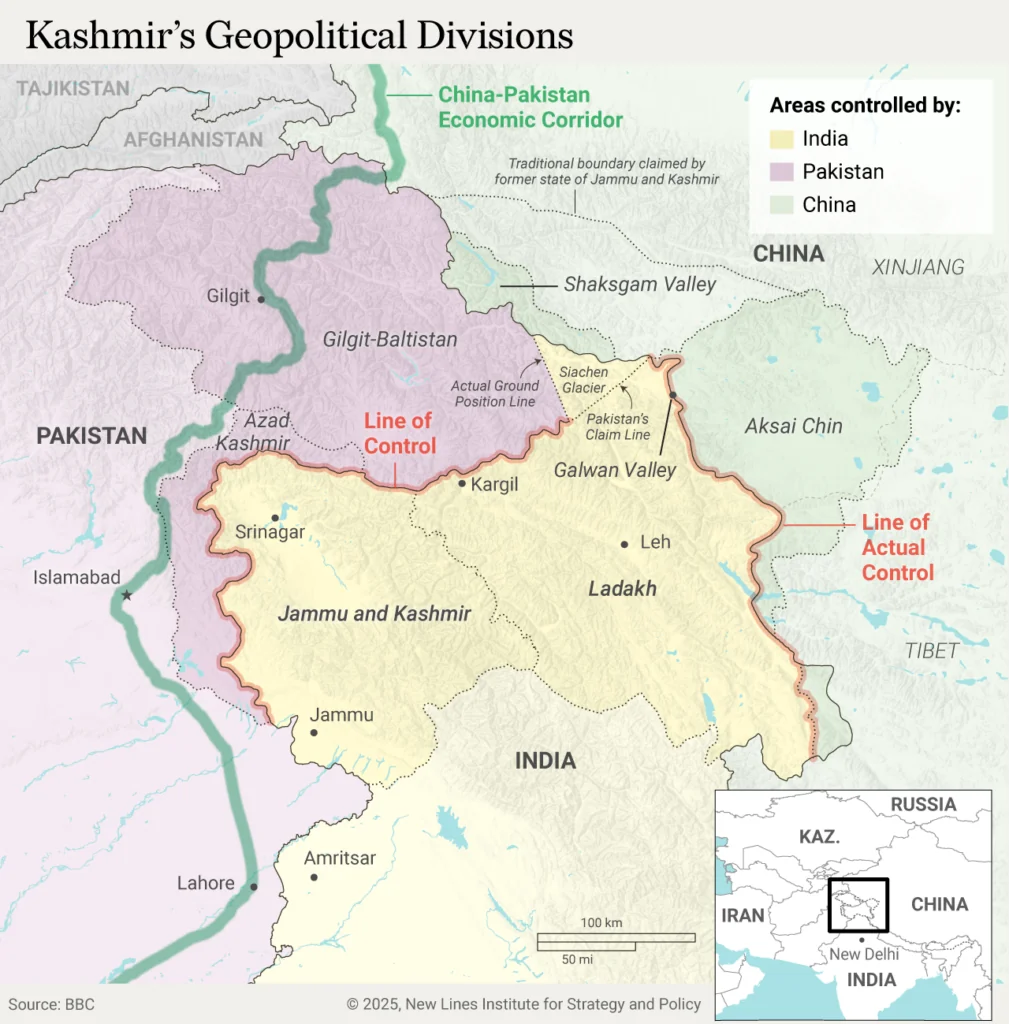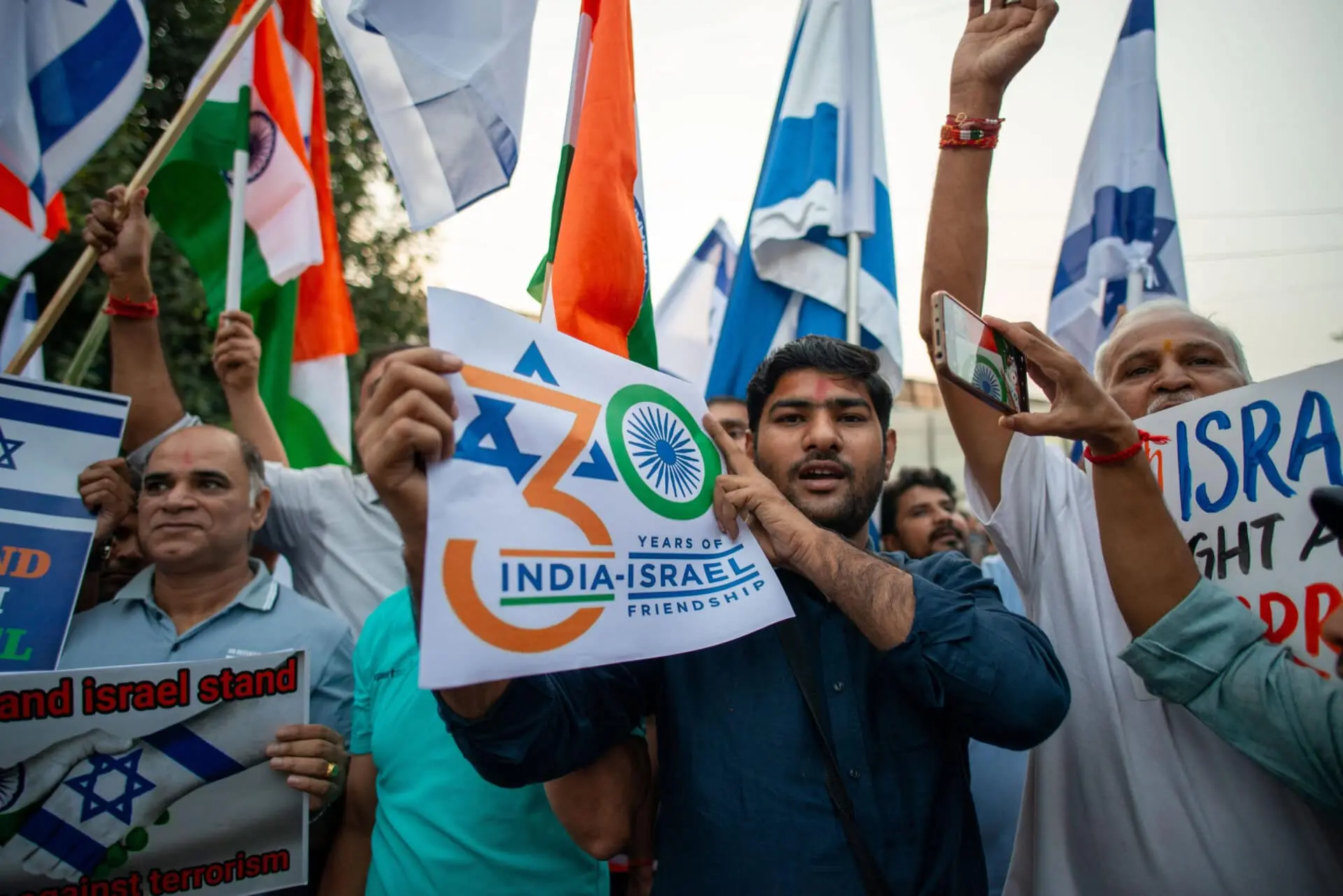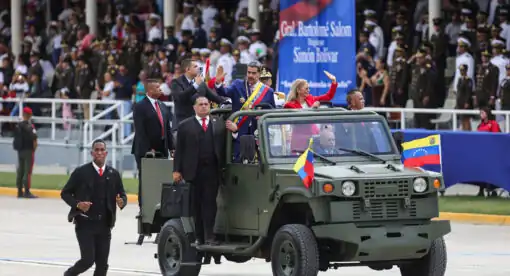This article is the first part of a series on Kashmir. Read part two, about Kashmir’s insugency, here. Read part three, about India-Pakistan water treaties, here.
Introduction
Israel’s claim to the occupied Palestinian territories (OPT) and India’s administration of Jammu and Kashmir (J&K) reflect an ideological alignment between Zionism and Hindutva. Both ideologies promote national identities rooted in religion — Zionism in pursuit of “a national home for the Jewish people” and Hindutva’s assertion that India’s national identity and culture are inseparable from Hinduism. These parallel strategies have done demonstrable harm to Palestinians in Israel and the 200 million Muslims residing in India, including the 8.5 million Muslims in J&K.
The United States promotes itself as a global champion of democracy and expects the same from its allies, but India and Israel exhibit symptoms of democratic backsliding in their approach to J&K and the OPT. Despite ratifying the U.N. Charter, their actions often run counter to its core tenets around state sovereignty and human rights. The U.S. has an obligation to address these issues through U.N.-backed mediation, enforcement of international law, and accountability measures. Doing so would reaffirm its credibility in the Global South and set a democratic precedent for all its allies.
As strategic partners, both nations receive substantial U.S. diplomatic, military, and economic support. If the U.S. continues to overlook the democratic erosion associated with their occupation policies, it risks undermining its stated values and fueling instability in regions critical to global security. Identifying the ideological parallels between India and Israel reveals a strategic pattern that demands an urgent U.S. policy response.
Britain’s Colonial Legacy
After 89 years of British colonial rule, India gained independence in 1947 and formally established itself as a “Sovereign Socialist Secular Democratic Republic,” a constitutional identity that reflected its commitment to religious pluralism, sovereignty, and democracy. Under Prime Minister Jawaharlal Nehru, India sought autonomy, resisting alignment with any major geopolitical blocs during the Cold War. This principle was driven by its co-founding of the Non-Aligned Movement (NAM) which championed peaceful co-existence and mutual nonaggression. India’s early opposition to Israel’s actions in the OPT aligned with NAM’s anticolonial ethos, and in 1974, India became the became the first non-Arab country to recognize the Palestinian Liberation Organization (PLO) as the legitimate representative of the Palestinian people.
Like Palestine, India bore the long-term consequences of hastily drawn borders left by British colonial withdrawal. In both regions, The United Kingdom’s abrupt departure sparked intractable territorial disputes. In India, the partition of 1947 created the notoriously hostile relationship between India and Pakistan over J&K. In Palestine, Britain’s withdrawal from the region and the establishment of Israel triggered the mass displacement of Palestinians they called the Nakba (catastrophe) and ongoing territorial clashes since 1948. These parallels emphasize how colonialism continues to affect the conflict dynamics and stability in both regions today.
The Partition of India
Sectarian conflict driven by religious divisions between India’s Hindu majority and Muslim minority contributed to Britain’s decision to partition India and Pakistan in 1947. India’s 584 semiautonomous princely states were left to decide whether to accede to India or Pakistan. Among them was J&K, a Muslim-majority region ruled by Maharaja Hari Singh, a Hindu.

J&K’s strategic location at the crossroads of South and Central Asia, bordering India, Pakistan, and China, made it a geopolitical attraction. The region’s mountainous terrain provided ideal military vantage points, and its natural resources and critical trade routes heightened its value. The dispute over J&K was not simply territorial: It was central to the interests of South and Central Asian countries.
Clashes over J&K intensified after the 1947 partition. Pakistan claimed the territory based on its Muslim-majority population, an assertion India disputed because it was Hindu-ruled. Fearing a Pakistani invasion, Singh acceded to India in exchange for constitutional protections as a semi-autonomous state under Articles 370 and 35-A. These provisions remained in India’s Constitution until the election of Prime Minister Narendra Modi in 2014 and rise of the Hindu nationalist Bharatiya Janata Party (BJP), which sought to merge J&K into the Indian union.
The Making of Modern Israel
Britain’s colonial legacy also led to sweeping changes in the Middle East, culminating in the U.N.’s 1947 recommendation to partition Palestine and create separate Arab and Jewish states. In May 1948, the birth of Israel was celebrated while half a million Palestinians became stateless refugees during the First Nakba.
The event foreshadowed the decades of struggle to come for displaced Palestinians, and the 1967 Six-Day War marked the start of Israel’s military occupation of the West Bank, Gaza Strip, and East Jerusalem. Despite U.N. Security Council Resolution 242 calling for Israel’s withdrawal from the OPT, Israel continued to pursue its vision of a “Greater Israel.”
Moreover, U.S. President Lyndon B. Johnson extended Israel unwavering diplomatic and security support, tying Israeli withdrawal to recognition of Israel by Arab states. In response, Arab states proposed the “land-for-peace” deal, offering Israel peaceful co-existence for Israel’s full withdrawal from the OPT, a proposal Israel rejected. Since 1967, Israel’s continued expansion and settlement activity has signaled an indifference to a two-state solution, undermining its commitment to a core democratic value and U.N. principle.
India-Israel Relations
Born weeks apart, India and Israel faced parallel existential challenges: Palestinian statehood and Pakistan’s claim to J&K. Despite this similarity, India hesitated to fully normalize relations with Israel, concerned it would undermine India’s position in the NAM, provoke unrest among India’s large Muslim minority, and weaken its relationships with Arab states.
Instead, it adopted a strategy of solidarity with Palestine. In 1947, it voted against the U.N. partition plan, and in 1948, Nehru said India can “play no part” in the Israel-Palestine issue. India did sustain dialogue with Israeli leadership, mainly through unofficial U.S. mediation efforts. In 1950, it officially recognized Israel, allowing an Israeli consulate to open in Mumbai to facilitate voluntary migration of Indian Jews to Israel.
During Indira Gandhi’s terms as prime minister, from 1966 to 1977 and from 1980 to 1984, India emphasized Palestinian solidarity to gain Arab support for its stance on J&K. In 1988, India was among the first countries to recognize the state of Palestine. Yet Arab states, driven by stronger pan-Islamic solidarity and closer ties with Pakistan, remained largely indifferent to India’s position on Kashmir.
As Arab support waned, Israel stepped in. The shift in public opinion was revealed in a 1967 poll that found twice as many Indians favoring treating Arabs and Jews equally over prioritizing Arab relations. Cooperation between India and Israel strengthened in the 1970s, most notably when Israeli Prime Minister Golda Meir provided military support to Gandhi during the 1971 Bangladesh Liberation War against Pakistan.
Throughout the 1970s and 1980s, Israel quietly provided India with intelligence, military advice, and diplomatic backing, positioning itself as a key ally. This relationship developed through backchannel communication between their foreign intelligence agencies, Israel’s Mossad and India’s Research and Analysis Wing. By 1992, India and Israel had established full diplomatic relations focused on trade, defense, and economic cooperation. The relationship became public during India’s 1999 Kargil War against Pakistan over J&K, when Israel emerged as a key defense supplier, providing India with vital surveillance equipment and laser-guided missiles.
Normalization with Israel did not come at the total expense of India’s anticolonial integrity. In 1996, India opened its Representative Office to the Palestine Authority in Gaza. This dual-track foreign policy approach enabled India to engage with Israel while preserving its relations with key Arab allies.
India, Israel, and the U.S.
India’s ideological admiration for Israel became politically actionable in J&K, particularly after the 9/11 attacks. While India maintained support for a two-state solution, it simultaneously deepened its ties with Israel and the U.S. Under the BJP’s leadership, Prime Minister Atal Bihari Vajpayee negotiated a $1.1 billion purchase of the Phalcon Airborne Warning and Control System (AWACS), co-produced by Israel and the U.S. The 2003 purchase marked a major milestone in Indian-Israeli relations, signaling to Indian policymakers and the BJP that leveraging Washington’s support to secure advanced military technology from Israel was critical to countering Pakistan.
As relations strengthened between India and Israel, so did the U.S. role in shaping India’s policy toward Israel. The atmosphere after 9/11 allowed far-right parties like the BJP and Israel’s Likud to exploit rising anti-Muslim/Arab sentiment to advance their agendas in the Palestinian territories and J&K. India’s National Security Adviser Brajesh Mishra described this ideological alliance among Likud, the BJP, and U.S. Republican Party in 2003 as a “tripartite axis” facing similar security threats. Modi echoed this sentiment in April 2025 following an attack on a group of tourists in J&K by anti-India gunmen. In response to the attack, U.S. President Donald Trump expressed solidarity with India, reaffirming the continuity of the alliance’s security narrative in Kashmir and beyond.
Zionism and Hindutva
Ideological parallels between Zionism and Hindutva embedded a long-standing admiration for Israel within the Hindu nationalist movement. In his book “Hindutva,” Vinayak Damodar Savarkar expressed support for Israel’s fulfilment of the “Zionist dream” and called for the creation of a Hindu state. Amid rising tensions in J&K, many Hindus demanded a more aggressive military campaign against Pakistan. Similar to the U.N.’s designation of Palestine as the Occupied Palestinian Territory after 1967, former Pakistani Prime Minister Imran Khan issued a directive in 2020 urging global media to describe India’s actions in Kashmir as a “military siege.”

As India grappled with forging a secular postcolonial identity, Hindu nationalism and deep anti-Muslim sentiment grew, some of it inspired by the far-right Hindu nationalist paramilitary organization Rashtriya Swayamsevak Sangh. Under Modi’s leadership, India’s domestic and foreign policies shifted to align with Hindutva. When the BJP came to power in 2014, it seized the opportunity to bring its Zionist-inspired vision to fruition.
Education and National Identity
Zionist ideology is introduced early in Israeli education. Israeli textbooks can play a critical role in promoting the “othering” of Palestinians, casting Arabs as an ideological threat to Israel. A Pew Research Center survey conducted in 2014-2015 found that “nearly half of Israeli Jews say Arabs should be expelled or transferred from Israel,” while 74% of Jews living in Israel reported they “do not see much discrimination against Muslims in Israel.” These findings point to the efficacy of state propaganda in desensitizing the public to the realities in the OPT.
For the BJP, Israel’s model of ideological conditioning proved instructive. It offered the party a framework to advance its goal of creating a “Hindu Israel” and achieve dominance in J&K. With nearly 40% of India’s population younger than 25, Modi prioritized school curriculum reforms to reshape India’s national identity. The goal was to “catch the Hindu minds young and instill the idea of ancient Hindu invincibility, a past when Hindu India was the dominant race all over the world.” In 2014, Modi launched a campaign to “saffronize education,” spreading Hindutva messaging through educational institutions run by the RSS.
The U.S. Department of State’s International Religious Freedom’s Report of 2023 described Hindutva-driven policies as restricting religious freedom, citing Karnataka’s High Court’s ruling allowing the banning of hijabs at a girls’ school in 2022. It also cited a February 2023 case where the Bajrang Dal, a Hindu nationalist militant organization, stormed a Catholic school in Gujarat, demanding Hindu deities be installed inside classrooms. Such incidents highlight an alarming trend of Hindu nationalists emboldened by the BJP and eroding India’s constitutional commitment to secularism.
Following the Oct. 7, 2023, attacks in Israel, anti-Muslim rhetoric surged across Indian social media outlets, especially in Muslim-majority areas like J&K. One WhatsApp chain that spread widely warned Hindus that “in the future, India could also face conspiracies and attacks like Israel. The possibility of Hindu women facing cruelty cannot be ruled out.”
The convergence between Zionism and Hindutva at times became literal. After the Oct. 7 attacks, Vishnu Gupta, the president of the Indian right-wing nationalist organization Hindu Sena, claimed that he and 200 others had volunteered for the Israeli army because both countries “are victims of Islamic terror.” He equated J&K to Jerusalem, stating, “just like Jerusalem was overtaken by Muslims, holy places in India were also invaded by Muslims,” and, “There are militants from Kashmir supported by Pakistan who would carry terror attacks across India.”
Identity Politics
Israeli Prime Minister Benjamin Netanyahu and Modi have employed similar strategies to reclaim the territorial integrity of their respective nations, particularly in the OPT and J&K. In 2018, Israel passed the “Nation-State Law” reestablishing Israel as the Jewish homeland and asserting its right to “promote and consolidate Jewish settlements,” citing historical and religious claims to the OPT as justification. The law made no mention of the Palestinian minority it housed or any mention of its commitment to democracy.
Moreover, the law explicitly limited the right to self-determination within the state to Jewish citizens exclusively, in direct violation of Article 1 (2) of the U.N. Charter. The law also stripped Arabic of its designation as an official language alongside Hebrew.
India’s BJP passed a similar exclusionary law in 2019. The Citizenship Amendment Act offered a pathway to citizenship for non-Muslims from Afghanistan, Pakistan, and Bangladesh, but not Muslims. This marked the first significant attempt at tying Indian citizenship to religious identity.
In 2021, the “Prohibition of Unlawful Conversion of Religion Act,” nicknamed the “love Jihad” law, prohibited Indian Muslim men from coercing Hindu women to convert to Islam prior to marriage, rendering such marriages illegal in some states if they involved religious conversion. The law, framed as a safety measure, disproportionately targeted Indian-Muslim men. This legislation represented a novel campaign by the BJP to gender Islamophobia using state-sanctioned law.
India’s anti-Muslim legislation accompanied a more aggressive military campaign in J&K. After the Modi government abolished Articles 350 and 37A from India’s Constitution in 2019, revoking J&K’s sovereign status and merging its 8 million Muslim-majority inhabitants with India, the government added 50,000 military and paramilitary personnel to the already 700,000-strong force in J&K, making it the most densely militarized zone in the world. This not only deepened Hindu-Muslim divisions within India but also signaled that the BJP’s Hindu nationalist agenda had evolved from religious exclusion to using military force to achieve its goals.
Evacuees and Absentees
This fusion of state-backed displacement and demographic engineering was not exclusive to India. Earlier in Israel’s approach to state-building, similar tactics were used to consolidate control and exclude its indigenous population. In March 1948, Israel established a Committee for Abandoned Arab Property, which allowed for the transferal of Palestinian properties to the state and ultimately to Jewish Israeli settlers. By March 1950, Israel passed the “Absentee Property Law,” which defined an “absentee” as anyone who had left their property as of Nov. 29, 1947. This prevented Palestinians expelled from the country in 1948 from returning home and stripped internally displaced Palestinian refugees of their property even if they remained in the country. To build a Jewish majority in Israel, the Knesset passed the Law of Return in 1950, granting Jewish people from around the world the right to attain Israeli citizenship, excluding Palestinian natives.
India, navigating its own post-partition landscape, adopted a similar approach to territorial acquisition and demographic reshaping in J&K. On April 17, 1950, it passed the “Evacuee Property Law,” which allowed the state to seize any vacant property in India, including in J&K. This law displaced over 40,000 families from West Pakistan after the 1947 partition.
The Promised Lands
While Zionism’s claim to the OPT is rooted in religion, Modi’s policies used Hindutva ideology as the basis for consolidating control over J&K. To understand the long-term objectives of both Zionism and Hindutva, it is essential to unpack the foundational narratives used by both movements to justify their claim to the contested lands.

The founding father of Zionism, Theodore Herzl, envisioned a “Greater Israel” from the “Brook of Egypt to the Euphrates.” This narrative, embraced by Christian and Jewish Zionists alike, cast modern-day Israel as an ancestral homeland that was promised to the Jewish people over 3,000 years ago. While the religious context explains the significance of Israel, it fails to address what would become of its indigenous Palestinian population, which also holds religious ties to Jerusalem.
Mirroring Israel’s approach, the BJP invoked Sanskrit mythological texts to advance the narrative of an indigenously Hindu Kashmir. The BJP used its influence to promote the Hindutva narrative that Muslim “invaders” sought to ethnically cleanse Pandits (Kashmiri Hindus) from their land and that any support for the self-determination of Kashmir was a threat to India and its Hindu majority. Since the BJP’s takeover of J&K, Modi has cleared a path toward the construction of militarized Hindu settlements in Kashmir, equipped with checkpoints and watchtowers, similar to Jewish-only settlements in the West Bank.
India’s diplomatic stance on the question of Palestine has come under increased scrutiny due to its contradictory nature. While India continues to vocalize its support for a two state-solution, its actions often diverge from this policy position. For example, in October 2023, India abstained during a U.N. General Assembly vote on a resolution calling for an immediate ceasefire after Israel began its retaliation for the Oct. 7 attacks. From India’s use of Israeli spyware technology (Pegasus) to it becoming the largest purchaser of Israeli weapons, Israel’s influence on India’s foreign policy is growing more evident.
Demographic Engineering
Prior to 1948, historic Palestine under Ottoman rule was home to Muslims, Jews, and Christians living in relative harmony, with Jerusalem serving as a central site for all. Similarly, J&K’s diverse religious fabric remained largely intact for decades due to its constitutionally protected semi-autonomous status. The ways in which Netanyahu and Modi consolidated power and expanded their ideological visions beyond legal boundaries are outlined below:
Tourism & Propaganda
Modi and Netanyahu relied on the support of their respective Hindu and Jewish-Zionist communities. With 15.7 million Jews worldwide, including 7.2 million living in Israel, and 1 billion Hindus in India, a robust propaganda strategy was essential to advancing visions of Hindu and Jewish supremacy. Netanyahu promoted the “birthright trip” as “a life-changing experience where young Jews could witness “the greatest story ever told: the rebirth of the Jewish people.”
Similarly, Modi aggressively promoted the “Amarnath Yatra” in 2014, a 43-day militarized Hindu pilgrimage into Kashmir. After the revocation of J&K’s special status in 2019, India vigorously encouraged tourism to normalize it as a holiday destination, despite the presence of security checkpoints, armored vehicles, and soldiers. In both contexts, by framing Palestinians and Kashmiri Muslims as ideological threat, Netanyahu and Modi reinforced the religious significance of these regions to justify ongoing military control.
Centralized Control of Institutions
Modi and Netanyahu have used legal tools to dismantle regional autonomy in the OPT and J&K. By centralizing political power and weakening local governance, they have diminished the legitimacy of indigenous claims to the land to advance long-term demographic changes. In Israel, the 2017 “Kaminitz Law” expanded Israel’s authority to seize Palestinian property, which led to high levels of demolitions of Palestinians’ homes, particularly in the West Bank. In India, the revocation of Article 35A stripped Kashmir’s legislative assembly of the power to define permanent residents and allocate exclusive land rights, opening the region to Hindu settlers and tourists.
International Law, Mediation, and the U.S.
The U.S. and the international community must face the reality that the unchecked nationalist policies of India and Israel have profound implications for global stability, particularly in regions plagued by conflict. As both India and Israel dismantle long-standing legal protections for highly contested areas, Washington must assess the broader consequences of its foreign policy approach and why it undermines international law and democratic values.
U.N. General Assembly Resolution 181 (1947) granted the city of Jerusalem an internationally recognized sovereign status due to its shared religious significance. However, Trump’s 2020 peace plan recognized a united Jerusalem as the capital of Israel, marking a departure from this international consensus.
Despite ostensibly being the only democracies in South Asia and the Middle East, Israel and India have pursued divisive policies that have triggered communal violence and created regional instability. The global response — or lack thereof — to India and Israel’s unchecked nationalism demonstrates the troubling trend that U.S. support shields these nations from accountability under international law.
As U.N. member states, India and Israel are obligated to uphold the principles of self-determination and minority rights outlined in the U.N. Charter. However, due to the veto power of the UNSC, the purpose of this international peacekeeping body is brought into question. Much like the League of Nations failed to prevent World War II, the U.N.’s structural inability to enforce international law equally threatens to undermine its purpose.
From a U.S. perspective, India is a buffer against China’s growing influence, and Israel is a buffer against Iran and its influence in the Middle East. This geopolitical dynamic has led the global community to condemn events such as the 150-day long internet blockade and communications blackout in Kashmir by India, or Israel’s control of water and electricity in the OPT , while the U.S. has largely turned a blind eye. By prioritizing geopolitical interests over upholding human rights and international law, the U.S. risks undermining its own moral standing by contributing to an environment where power and politics override human dignity.
Ultimately, the U.S.’s silence on human rights violations has serious global repercussions. This approach sets a dangerous precedent for future policy decisions, where international law is undermined for short-term strategic gains. The U.S. risks its partnerships with allies in the Middle East and South Asia, particularly its credibility as a promoter of democracy and peace. Furthermore, if its biased foreign policy orientation toward India and Israel persists, it could drive allies in both regions toward China for security and diplomatic support due to its selective engagement. Without a more balanced approach that integrates human rights with strategic interests, the U.S. will find it difficult to shape and implement a rules-based international order.
Policy Recommendations
Conditional Aid: The U.S. should tie diplomatic and security backing to clear human rights benchmarks. In doing so, the U.S. will ensure that India, Israel, and its other allies align with international standards of justice and accountability.
Engage Civil Society: The U.S should center local voices in peacebuilding and conflict resolution practices, engaging with grassroots organizations and community leaders in Israel and Kashmir. By empowering local communities, this will ensure that the realities and needs of those affected are prioritized.
U.S. Mediation/Arbitration: The U.S. should focus on diplomatic mediation efforts, encouraging dialogue among India, Pakistan, and Kashmir’s leadership. By promoting multilateral efforts in J&K, the U.S. can help set a precedent for international intervention that can be leveraged in the case of Israel and the OPT.
International Law/Sanctions: The U.S., in collaboration with the U.N. and the International Court of Justice, should develop a renewed framework for defining violations of international law.
Sovereignty: The U.S. and its Arab allies must advocate for a renewed two-state solution in Israel that addresses key issues, such as sovereignty, human rights, and an end to military occupation. If a successful resolution is reached, this can serve as a model for conflict resolution in J&K, highlighting the salience of regional cooperation and self-determination in both regions.
Zara Farouk holds a bachelor’s degree in Conflict Analysis and Resolution with a minor in International and Comparative Studies from George Mason University, focusing on the MENA region. She furthered her expertise with an MA in International Law and Diplomacy from The Fletcher School at Tufts University, specializing in the Middle East. Zara’s professional experience includes working with the Embassy of India, where she gained valuable insights into India’s foreign policy, and with the human rights organization “One Voice,” which advocates for a two-state solution to the Israel-Palestine conflict. These experiences have shaped her understanding of the region and the importance of dialogue and peace-building.
The views expressed in this article are those of the author and not an official policy or position of New Lines Institute.






